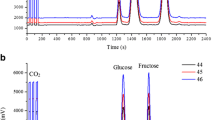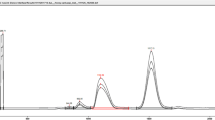Abstract
In this study, δ 2H values of honey were detected and then applied to the identification of honey adulteration. In the meantime, δ 13C values of honey, its protein fraction, and individual sugar (glucose and fructose) were also determined by EA-IRMS and LC-IRMS, which combined with δ 2H values of honey, have been developed to improve isotopic methods devoted to the research of honey authenticity. For this purpose, 58 Chinese commercial honey samples from various origins were analyzed. The results indicated that the ranges of δ 13Choney and δ 13Cprotein of these samples were from −28.833 to −10.886 ‰ and −28.327 to −21.632 ‰, respectively. Interestingly, a very strong correlation was observed between δ 13Choney value and δ 13Cprotein value of pure honey. Moreover, δ 2H values of the honey samples were calculated between −156.725 and −170.029 ‰. The comprehensive procedure has advantages over existing methods in terms of time and sensitivity.



Similar content being viewed by others
References
Anklam E (1998) A review of the analytical methods to determine the geographical and botanical origin of honey. Food Chem 63:549–562
AOAC (1995) Corn and cane sugar products in honey. Off Method Anal (978.17) 44:27–29
Cabañero AI, Recio JL, Rupérez M (2006) Liquid chromatography coupled to isotope ratio mass spectrometry: a new perspective on honey adulteration detection. J Agric Food Chem 54:9719–9727
Camin F, Larcher R, Perini M, Bontempo L, Bertoldi D, Gagliano G, Nicolini G, Versini G (2010) Characterisation of authentic Italian extra-virgin olive oils by stable isotope ratios of C, O and H and mineral composition. Food Chem 118:901–909
Chen LZ, Xue XF, Ye ZH, Zhou JH, Chen F, Zhao J (2011) Determination of Chinese honey adulterated with high fructose corn syrup by near infrared spectroscopy. Food Chem 128:1110–1114
Codex Stan 12 (1981) Revised condex standard for honey. The Codex Alimentarius Standard
Cordella C, Antinelli JF, Aurieres C, Faucon JP, Carbol-Bass DC, Sbırrazzuoli N (2002) Use of differential scanning calorimetry (DSC) as a new technique for detection of adulteration in honeys. 1. study of adulteration effect on honey thermal behavior. J Agric Food Chem 50:203–208
Cordella CBY, Militao JSLT, Clement MC, Carbol-Bass DC (2003) Honey characterization and adulteration detection by pattern recognition applied on HPAEC-PAD profiles. 1. honey floral species characterization. J Agric Food Chem 51:3234–3242
Doner LW, White JW (1977) 13C/12C ratio relatively uniform among honeys. Science 197:891–892
Elflein L, Raezke KP (2008) Improved detection of honey adulteration by measuring differences between 13C/12C stable carbon isotope ratios of protein and sugar compounds with a combination of elemental analyzer-isotope ratio mass spectrometry and liquid chromatography-isotope ratio mass spectrometry 13C/12C-EA/LC-IRMS. Apidologie 39:574–587
Eric J, Frédérique M, Rebeca SF, Miche LL (2005) Detection of exogenous citric acid in fruit juices by stable isotope ratio analysis. J Agric Food Chem 53:5130–5133
GB method of China (2002) Determination method of C-4 sugar content in honey: stable carbon isotope ratio analysis (18932.1)
Giovanni C, Norbert N, Claude G, Fabiano R (2004) Characterization of European wine glycerol: stable carbon isotope approach. J Agric Food Chem 52:5902–5906
Guler A, Bakan A, Nisbet C, Yavuz O (2007) Determination of important biochemical properties of honey to discriminate pure and adulterated honey with sucrose (Saccharum officinarum L.) syrup. Food Chem 105:1119–1125
Guler A, Kocaokutgen H, Garipoglu AV, Onder H, Ekinci D, Biyik S (2014) Detection of adulterated honey produced by honeybee (Apis mellifera L.) colonies fed with different levels of commercial industrial sugar (C3 and C4 plants) syrups by the carbon isotope ratio analysis. Food Chem 155:155–160
Jacob D, Kerklivet H, Meijer AJ (2000) Adulteration of honey: relation between microscopic analysis and 13C/12C measurements. Apidologie 31:717–726
Longobardi F, Casiello G, Sacco D, Tedone L, Sacco A (2011) Characterisation of the geographical origin of Italian potatoes, based on stable isotope and volatile compound analyses. Food Chem 124:1708–1713
Morales V, Corzo N, Sanz ML (2008) HPAEC-PAD oligosaccharide analysis to detect adulterations of honey with sugar syrups. Food Chem 107:922–928
Padovan GJ, Jong DD, Rodrigues LP, Marchini JS (2003) Detection of adulteration of commercial honey samples by the 13C/12C isotopic ratio. Food Chem 82:633–636
Padovan GJ, Rodrigues LP, Leme IA, Jong DD, Marchini JS (2007) Presence of C4 sugars in honey samples detected by the carbon isotope ratio measured by IRMS. Eurasian J Anal Chem 2:134–141
Ruiz-Matute AI, Soria AC, Martinez-Castro I, Sanz ML (2007) New methodology based on GC-MS to detect honey adulteration with commercial syrups. J Agric Food Chem 55:7264–7269
Ruiz-Matute AI, Weiss M, Sammataro D, Finley J, Sanz ML (2010) Carbohydrate composition of high fructose corn syrups (HFCS) used for bee feeding effect on honey composition. J Agric Food Chem 58:7317–7322
Schneider R, Kotseridis Y, Ray JL, Augier C, Baumes R (2003) Quantitative determination of sulfur-containing wine odorants at sub parts per billion levels. 2. development and application of a stable isotope dilution assay. J Agric Food Chem 51:3243–3248
Serap B, Aziz E, Ìknur C (2014) Carbon isotope ratio (13C/12C) of pine honey and detection of HFCS adulteration. Food Chem 157:10–13
Simsek A, Bilsel M, Goren AC (2012) 13C/12C pattern of honey from Turkey and determination of adulteration in commercially available honey samples using EA-IRMS. Food Chem 130:1115–1121
Sivakesava S, Irudarayaj J (2001) A rapid spectroscopic technique for determining honey adulteration with corn syrup. J Food Sci 66:787–792
Sivakesava S, Irudarayaj J (2002) Classification of simple and complex sugar adulterants in honey by mid-infrared spectroscopy. Int J Food Sci Technol 37:351–360
Tosun M (2013) Detection of adulteration in honey samples added various sugar syrups with 13C/12C isotope ratio analysis method. Food Chem 138:1629–1632
Wang S, Guo Q, Wang L, Lin L, Shi H, Cao H, Cao B (2015) Detection of honey adulteration with starch syrup by high performance liquid chromatography. Food Chem 172:669–674
White JW (1980) Detection of honey adulteration by carbohydrate analysis. J Assoc Off Anal Chem 66:11–18
White JW (1992) Internal standard stable carbon isotope ratio method for determination of C4 plant sugar in honey. J AOAC Int 75:543–548
White JW, Winters K (1989) Honey protein as internal standard for stable carbon isotope ratio detection of adulteration honey. J Assoc Of Anal Chem 72:907–911
Acknowledgments
This work was supported by science and technology project of Quality and Technical Supervision of Guangdong Province (2011ZS01) and science and technology plan project of Guangzhou City (2011 J2200016). At the same time, the authors would like to thank all the workers for sampling, sample preparation, and measurement.
Conflict of Interest
Donghui Luo declares that he has no conflict of interest. Haiying Luo declares that she has no conflict of interest. Hao Dong declares that he has no conflict of interest. Yanping Xian declares that she has no conflict of interest. Xindong Guo declares that he has no conflict of interest. Yuluan Wu declares that she has no conflict of interest. This article does not contain any studies with human or animal subjects.
Author information
Authors and Affiliations
Corresponding author
Additional information
Donghui Luo and Haiying Luo contributed equally to this work.
Electronic supplementary material
Below is the link to the electronic supplementary material.
ESM 1
(DOC 56 kb)
Rights and permissions
About this article
Cite this article
Luo, D., Luo, H., Dong, H. et al. Hydrogen (2H/1H) Combined with Carbon (13C/12C) Isotope Ratios Analysis to Determine the Adulteration of Commercial Honey. Food Anal. Methods 9, 255–262 (2016). https://doi.org/10.1007/s12161-015-0202-y
Received:
Accepted:
Published:
Issue Date:
DOI: https://doi.org/10.1007/s12161-015-0202-y




